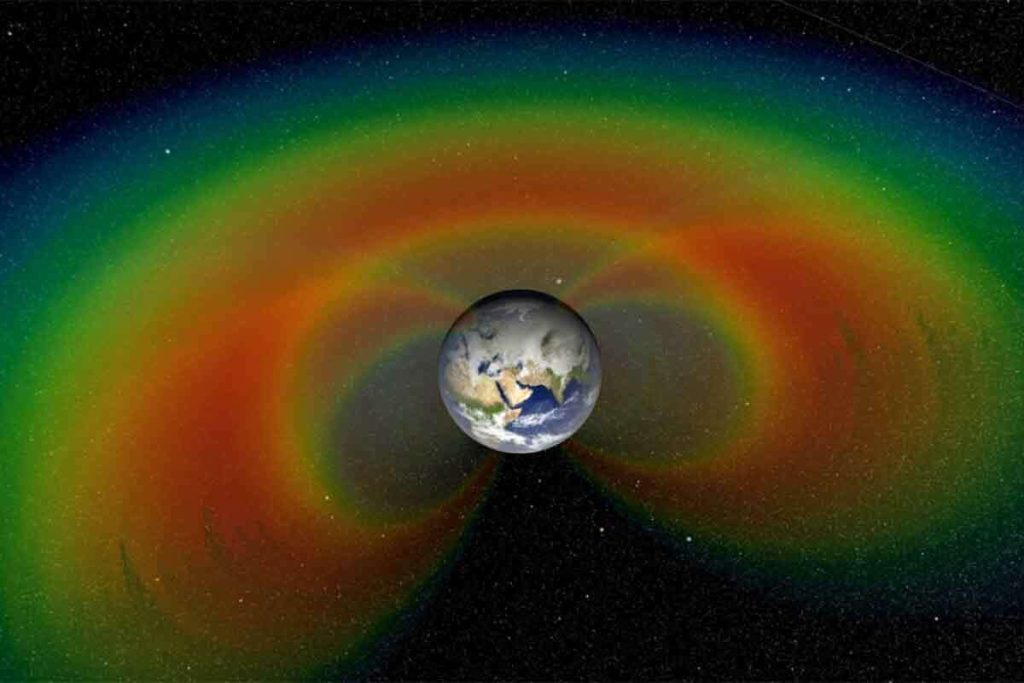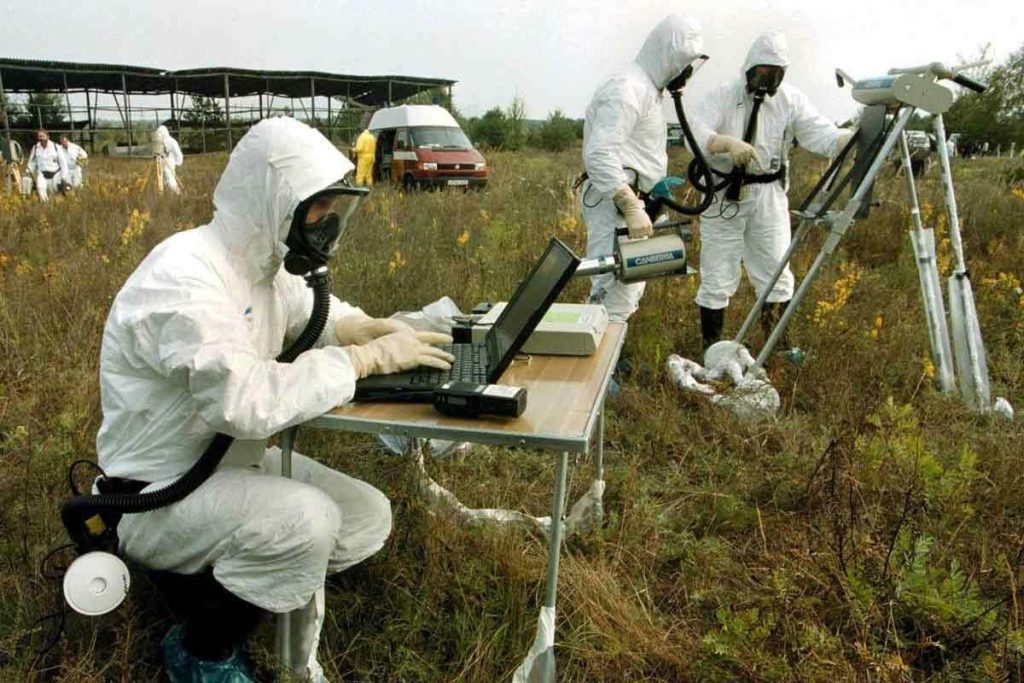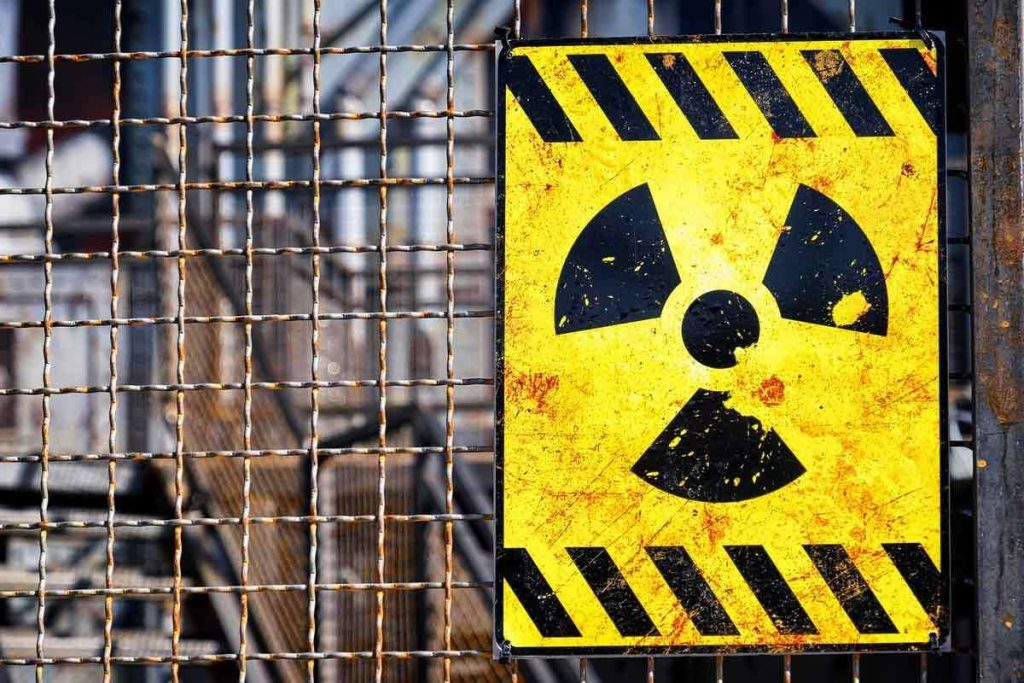Last Updated on October 21, 2025 by mcelik

Radiation is everywhere in our lives, from medical treatments to powering our devices. At Liv Hospital, we use the latest science to provide top-notch care. Electromagnetic radiation is a key type seen in science and medicine. Two examples of radiation are X-rays and radio waves, which answer the question, “what are two examples of radiation.” It also includes microwaves, visible light, and more.
Electromagnetic radiation covers a wide range of frequencies. From low radio waves to high gamma rays, we’ll look at five key examples of radiation. We’ll see how they matter in medicine and more.

Understanding radiation is key to knowing how energy moves and affects our world. Radiation is energy that comes from a source and travels through space. It can be different types, like electromagnetic radiation, which has a wide range of energies.
In simple terms, radiation is energy that moves as waves or particles. There are two main types: non-ionizing and ionizing. Non-ionizing radiation has low energy and doesn’t remove electrons from atoms. Electromagnetic radiation, like radio waves and visible light, is an example.
Ionizing radiation, however, has enough energy to remove electrons and create ions. X-rays and gamma rays are examples used in medicine. Knowing the difference is important for understanding their effects.
Radiation moves through space mainly as electromagnetic waves. These waves can travel through a vacuum, unlike other waves that need a medium. The speed of these waves in a vacuum is about 299,792 kilometers per second, which is the speed of light.
The distance radiation travels depends on its energy and the medium it goes through. For example, gamma rays can go far, while radio waves can also travel long distances but are more easily blocked.
Examples of radiation include visible light, which we need to see, and radio waves, which help with wireless communication. Knowing how radiation moves and interacts with matter is crucial for many technologies and sciences.

Radiation comes in many forms. The electromagnetic spectrum helps us understand these different types. It ranges from low-energy, long-wavelength forms like radio waves to high-energy, short-wavelength forms like gamma rays.
The electromagnetic spectrum is arranged from low-energy to high-energy radiation. This helps us see the wide range of electromagnetic radiation. The types of radiation, in order of increasing energy, are:
For instance, seven types of electromagnetic waves are commonly recognized. Each has its own properties and uses.
The electromagnetic spectrum shows a key relationship between frequency, wavelength, and energy. As energy increases, frequency goes up and wavelength goes down. This is shown by the equation E = hf, where E is energy, h is Planck’s constant, and f is frequency. Knowing this helps us understand how different types of radiation interact with matter.
The electromagnetic spectrum divides into ionizing and non-ionizing radiation. Non-ionizing radiation, like radio waves and visible light, can make atoms vibrate but not remove electrons. Ionizing radiation, like X-rays and gamma rays, can remove electrons and create ions. X-rays and gamma rays are two examples of radiation that are ionizing because of their high energy.
It’s important to know the difference between ionizing and non-ionizing radiation. Non-ionizing radiation is usually safe at low levels. But ionizing radiation can damage DNA and raise cancer risk.
X-rays and gamma rays are key examples of radiation that have changed medical science. They have unique properties and uses, especially in medicine.
X-rays are used mainly for medical imaging. They let us see inside the body, helping find many health issues. This has greatly improved how we care for patients by giving fast and accurate diagnoses.
Key applications of X-rays include:
Gamma rays are the most energetic form of electromagnetic radiation. They are often given off by radioactive materials. They are used in cancer treatment, known as radiation therapy.
The therapeutic use of gamma rays shows the two sides of radiation. It can be dangerous, but also save lives. Gamma radiation therapy is precise, targeting cancer cells while sparing healthy tissues.
Visible light is key for our vision. It’s part of the electromagnetic spectrum. This spectrum ranges from radio waves to gamma rays. It lets us see, tell colors, and view objects clearly.
The visible spectrum spans wavelengths our eyes can see, from 380 to 750 nanometers. This range lets us see colors from violet to red. Color science is complex, mixing light’s physical properties with our eye’s biology.
Light comes from nature and man-made sources. The sun is our main natural source, emitting light across the spectrum. Artificial lights, like bulbs and LEDs, serve different needs.
Visible light is vital in tech and medicine. In tech, it’s used in screens and communication systems. In medicine, it helps in diagnosis and treatments like phototherapy for newborns.
| Application Area | Examples | Benefits |
| Technology | Displays, Optical Communication, Lighting | Enhanced visibility, Energy efficiency, Improved communication |
| Medicine | Diagnostic tools, Phototherapy | Accurate diagnosis, Effective treatment |
Knowing about visible light helps us improve tech and medicine. As we learn more about the electromagnetic spectrum, we find ways to better our lives and healthcare.
Radio waves are a key part of our daily lives. They help with wireless communication and broadcasting. We use them every day, but often don’t think about their importance.
James Clerk Maxwell predicted radio waves in the 19th century. Heinrich Hertz later proved their existence. These waves have long wavelengths and low frequencies.
Because of their properties, radio waves are great for long-distance communication. They can pass through the air and some solid objects. But, their range and strength can change due to terrain and weather.
Radio waves are key in broadcasting. They help us get radio and TV signals. In telecommunications, they’re vital for mobile phones, allowing us to talk and send data over long distances.
These uses depend on radio waves’ ability to carry information far. They’re a crucial part of our modern communication systems.
Radio waves also play a role in science, especially in radio astronomy. Scientists use them to study objects in space that can’t be seen with regular telescopes.
Radio astronomy has made many discoveries. It helped find the cosmic microwave background radiation. This finding supported the Big Bang theory.
Key applications of radio waves in science include:
By studying radio waves, we learn more about our technology and the universe. It helps us understand both our daily lives and the vastness of space.
Microwave radiation is not just for kitchen appliances. It plays a big role in technology, science, and industry too. We often forget how important microwaves are in these areas.
Microwaves heat up things through dielectric heating. When microwaves hit a material, they make water molecules move. This movement creates heat through friction, cooking or heating the material. This principle is not only used in microwave ovens but also in various industrial processes.
Microwave heating is very efficient. It’s used in drying materials, cutting down on time and improving quality.
Microwaves are key in telecommunications, especially for satellite communications. Satellite transmissions use microwaves to send data over long distances, helping with global communication networks. They work well because microwaves can go through the Earth’s atmosphere with little interference.
Microwaves are used in science and industry too. In research, microwaves help study materials at the molecular level. Microwave spectroscopy lets scientists look at molecular structure.
In industry, microwaves are used for many things. For example:
Microwave radiation has many uses beyond kitchen appliances. Its ability to heat efficiently and transmit data makes it valuable in many fields.
Ultraviolet and infrared radiation are key parts of our lives. They are invisible but play big roles. They are found in the electromagnetic spectrum and are used in many fields.
Ultraviolet (UV) radiation is invisible but has good and bad sides. It’s used in sterilization processes to kill bacteria in hospitals and labs. It also helps make vitamin D in our skin.
But too much UV radiation can harm our skin and raise cancer risks. It’s important to protect ourselves when we’re exposed to UV.
Infrared (IR) radiation feels like heat to us. It’s used in thermal imaging and heating systems. It’s also used in drying and curing in industries.
IR radiation is used in medical treatments for pain and in night vision devices for seeing in the dark.
Ultraviolet and infrared radiation are both important in the electromagnetic spectrum. They have special uses and effects. Knowing about them helps us use their benefits and avoid their dangers.
Our world is full of natural radiation sources that we often ignore. Many think of radiation as something made by humans, but it’s everywhere in nature. It comes from many different places.
Cosmic radiation comes from space, mainly from the sun and deep space. It’s made up of high-energy particles that hit our planet all the time.
Cosmic radiation levels change with altitude and where you are on Earth. Places high up, like mountains or when flying, get more cosmic radiation. This is a worry for those who fly a lot or live in high places.
Terrestrial radiation is from the Earth itself. It’s from radioactive materials like uranium and thorium in the soil, rocks, and buildings.
The amount of terrestrial radiation varies a lot. Places with lots of uranium and thorium in the rocks get more radiation.
Radon is a gas that comes from uranium in the soil. It builds up in buildings, especially in basements and crawl spaces. It’s a big source of natural radiation.
Other radioactive materials like potassium-40 and lead-210 are also in the environment. They’re found in small amounts everywhere.
Background radiation levels change around the world. This is because of differences in cosmic and terrestrial radiation. Some places get more radiation because of their geology or how high they are.
| Location | Average Annual Dose (mSv) |
| Global Average | 2.4 |
| High Background Areas | Up to 100 |
| Average Sea Level | 1.0 |
Knowing about natural radiation sources helps us understand our world better. By learning about these sources, we can control our exposure. This helps us make better choices for our health and safety.
In today’s world, man-made radiation is all around us. It comes from medical tech, consumer goods, and industrial uses. We’re surrounded by radiation from medical scans, electronic devices, and nuclear power.
Medical procedures are a big source of man-made radiation. Techniques like X-rays, CT scans, and PET scans use radiation to help diagnose and treat diseases. These methods are vital for health but also increase our radiation exposure.
A chest X-ray gives a patient about 0.1 millisieverts (mSv) of radiation. But a CT scan of the abdomen and pelvis can expose a patient to around 10 mSv. It’s important for both doctors and patients to understand the benefits and risks of these scans.
Many consumer products and electronic devices also emit radiation. For example, microwave ovens use microwaves to heat food. Some lighting, like fluorescent lamps, and older TVs and computer monitors also emit low levels of radiation.
Even though the radiation from these devices is generally safe, it’s good to follow the manufacturer’s guidelines. For instance, standing back from a microwave oven while it’s on can reduce your exposure to microwave radiation.
Nuclear power plants use nuclear reactions to generate electricity, which involves radiation. These plants have many safety measures to prevent leaks. But they are still a source of man-made radiation. Industrial uses, like certain manufacturing and weld inspections, also use radiation.
To grasp the impact of man-made radiation, comparing exposure levels is helpful. The table below shows average doses from different sources.
| Source | Average Dose (mSv) |
| Chest X-ray | 0.1 |
| CT Scan (Abdomen & Pelvis) | 10 |
| Flight from New York to Los Angeles | 0.035 |
| Nuclear Power Plant (annual exposure limit for workers) | 50 |
Understanding man-made radiation sources and levels helps us see the need for safety and regulations. As technology grows, new radiation sources will likely appear. So, staying informed and aware is key.
Many people get radiation mixed up with other things. It’s important to know what radiation really is. This helps us understand different types of energy better.
Some think sound waves are a type of radiation. But, sound waves are actually mechanical waves. They need a medium to move, unlike electromagnetic waves that can go through a vacuum.
For example, when you listen to music, sound waves travel through the air as pressure waves. This is different from radio waves, which are electromagnetic and used for broadcasting.
Heat transfer is another area where confusion happens. While radiation is a way to transfer heat, conduction and convection are not. Conduction happens when objects touch, and convection is when heated particles or fluids move.
For instance, when you hold a hot cup of coffee, the heat goes to your hands through conduction. The warm air in a heated room moves through convection. Neither of these is electromagnetic radiation.
It’s key to know the difference between electrical fields and electromagnetic radiation. An electrical field is static and surrounds charged particles. Electromagnetic radiation, on the other hand, has oscillating electric and magnetic fields that move through space.
Think of it like this: a stationary charge has an electric field, but an oscillating charge makes electromagnetic radiation. For example, the Earth’s gravitational field is not radiation, just like a static electric field is not.
| Phenomenon | Type | Characteristics |
| Sound Waves | Mechanical Waves | Require a medium, not electromagnetic |
| Heat Conduction | Heat Transfer | Direct contact, not radiation |
| Electrical Fields | Static Fields | Surround charged particles, not propagating |
Understanding these differences helps us see what radiation really is. Examples of radiation include X-rays, gamma rays, and visible light. Knowing what isn’t radiation helps us understand its role in science and technology better.
We’ve looked at the many types of radiation around us. This includes radio waves, microwaves, X-rays, and gamma-rays. Knowing about these, like X-rays in medical imaging and gamma-rays in cancer treatment, shows how important radiation is to us.
Radiation is all around us, from natural sources to things made by humans. The electromagnetic spectrum, which includes light and other types of radiation, helps us understand the world. By studying radiation, we learn more about the universe and create new technologies.
To learn more about the electromagnetic spectrum, check out the NASA resource. It gives a detailed look at different types of radiation and how they’re used. As we learn more about radiation, we can use it to make our lives better and help medical research.
Radiation is energy that moves through space as waves or particles. It can be divided into non-ionizing and ionizing types.
Radiation examples include X-rays, gamma rays, and visible light. Also, radio waves, microwaves, ultraviolet, and infrared radiation.
Ionizing radiation, like X-rays, can remove electrons from atoms. Non-ionizing radiation, such as radio waves, has less energy and doesn’t ionize atoms.
Natural radiation sources include cosmic rays from space and terrestrial radiation from the Earth. Also, radon and other radioactive materials.
Man-made radiation sources include medical procedures and consumer products. Also, electronic devices and nuclear power.
No, sound waves are not electromagnetic radiation. They are mechanical waves that need a medium to travel.
In medicine, radiation is used for X-rays in imaging and gamma radiation therapy for cancer treatment.
The electromagnetic spectrum includes all frequencies of electromagnetic radiation. This includes radio waves, microwaves, infrared, visible light, ultraviolet, X-rays, and gamma rays.
Misconceptions include thinking all radiation is harmful and that sound waves are radiation. Also, believing electrical fields are electromagnetic radiation.
We can be exposed to radiation from natural sources like cosmic rays. Also, from man-made sources like medical procedures and consumer products.
Non-ionizing radiation examples include radio waves, microwaves, infrared, and visible light.
Microwave radiation heats food by making water molecules vibrate. It’s used in cooking, telecommunications, and more.
Subscribe to our e-newsletter to stay informed about the latest innovations in the world of health and exclusive offers!
WhatsApp us